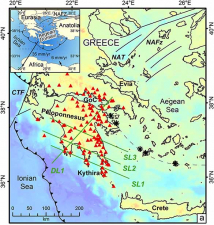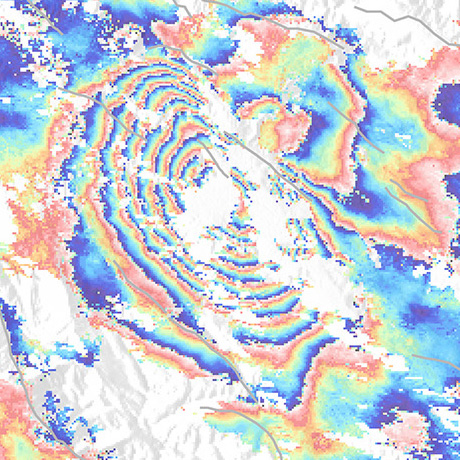Flagship Research Projects
{imageshow sl=23 sc=6 w=800 h=400 /}
SISMED - Seismic Imaging inveStigation in MEDiterranean Sea for deep seismogenic faults
- Details
 The southwestern segment of the Hellenic subduction zone has generated a M>8 tsunamigenic earthquake in the past (365 AD), the largest event ever reported in Europe, but fundamental questions remain about the deep geometry and characteristics of the interplate fault and connected splay faults in the overriding plate that might be rooted in the megathrust. In the Fall 2015, we chartered the R/V Marcus Langseth equipped with unmatched seismic facilities in the European academic fleet by means of a strong mobilization of the French and American involved laboratories (Géoazur, LDEO, ISTEP, ENS-Paris, EOST, LDO, Pau Univ.) and their research agencies (CNRS, NSF, OCA, and UCA).
The southwestern segment of the Hellenic subduction zone has generated a M>8 tsunamigenic earthquake in the past (365 AD), the largest event ever reported in Europe, but fundamental questions remain about the deep geometry and characteristics of the interplate fault and connected splay faults in the overriding plate that might be rooted in the megathrust. In the Fall 2015, we chartered the R/V Marcus Langseth equipped with unmatched seismic facilities in the European academic fleet by means of a strong mobilization of the French and American involved laboratories (Géoazur, LDEO, ISTEP, ENS-Paris, EOST, LDO, Pau Univ.) and their research agencies (CNRS, NSF, OCA, and UCA).
E-POST - The Early POSTseismic Deformation
- Details
 The Early POSTseismic Deformation: a Key Process in the Earthquake Cycle. From Observation to Modeling.
The Early POSTseismic Deformation: a Key Process in the Earthquake Cycle. From Observation to Modeling.
The main objective of the project is to better understand the complex space and time evolution of postseismic transient processes to better assess their link with the coseismic processes and how they contribute to the stress redistribution, which might lead to the generation of catastrophic seismic sequences. The originality of the project is to focus on the shorter time scale of the postseismic phase, the transition from the co- to postseismic (i.e. early postseismic, from minutes to early days) and to test to what extent the better description and knowledge of the co- and early postseismic deformation help to resolve the longer time-scale postseismic deformation (months - years).
The E-POST Young Researcher project is supported by the main French Research Funding Agency ANR over the period 2015-2019.
HYDROSEIS - Role of fluids and fault HYDROmechanics on SEISmic rupture
- Details
 The main objective is to improve our understanding of the role of fluids on the rupture of earthquake faults. To date, few data are available to study the couplings between fluids, fault slip and seismicity. In this project, we propose to develop a new in-situ approach based on the hydraulic stimulation of a small fault segment (10 m) under controlled experimental conditions.
The main objective is to improve our understanding of the role of fluids on the rupture of earthquake faults. To date, few data are available to study the couplings between fluids, fault slip and seismicity. In this project, we propose to develop a new in-situ approach based on the hydraulic stimulation of a small fault segment (10 m) under controlled experimental conditions.
The fluid injections will produce small fault slip (few millimeters) and will be monitored with a dense network of sensors, including pressuremeters, strainmeters, seismometers and electrical imaging. This original experiment will be conduct at 300 m-depth at the Low Noise Underground Laboratory of Rustrel in France.
UMR Géoazur
Campus Azur du CNRS
250 rue Albert Einstein
- CS 10269 - F 06905 SOPHIA ANTIPOLIS Cedex
+33 (0)483 618 500




